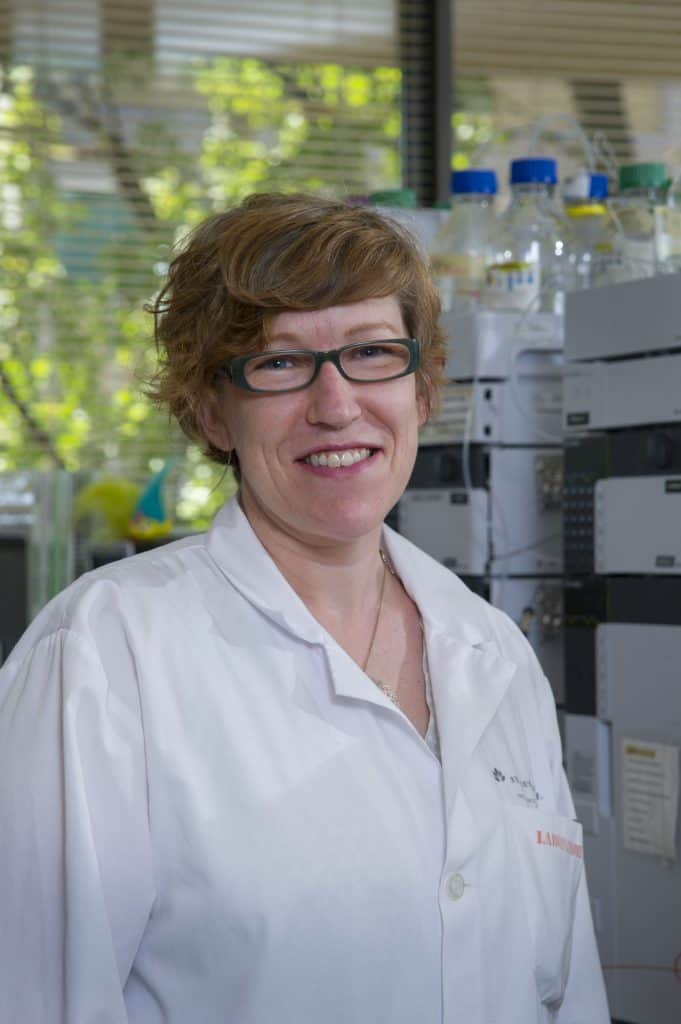Three out of four medical decisions at St. Paul’s can be based on results from the lab—meet one of the many behind-the-scenes stars
Grace van der Gugten is an assay development scientist in the Department of Pathology and Laboratory Medicine at St. Paul’s, where her expertise in developing assays and using mass spectrometry make her a key figure in one of Canada’s most innovative medical labs.
To learn more about Grace, you only need to ask the people she works with.
“Grace makes everyone around her better,” Dr. Andre Mattman, a medical biochemist, says of his colleague.
“Grace underpins our entire assay program,” says Dr. Dan Holmes, Division Head of Clinical Chemistry at St. Paul’s, “and in the process has a profound impact on the entire hospital.”
“We need another Grace,” says clinical chemist Dr. Mari DeMarco, another appreciative colleague. “But to find someone like that is very difficult.”
To find someone worthy of such praise from her peers does sound difficult—but finding Grace, it turns out, was not so tough. Instead, it’s a story of serendipity.
The private sector’s loss is St. Paul’s gain
Given her status among her colleagues, one may think an international recruiter brought Grace to St. Paul’s, but it was a much more down-to-earth origin story. To be specific, a slow-down at an analytics company.
Grace came to St. Paul’s in 2011 from the contract research industry where she worked as an assay developer for one of BC’s leading analytical laboratories. When the company she worked for closed some of its analytical testing departments, a contact of Dr. Holmes let him know about Grace.
Dr. Holmes and Dr. Mattman found themselves with room in their budgets to hire Grace on a contract basis. But then, not much more than a year later, something extraordinary happened.
“Everything was done!” says Dr. Holmes. “All the assays had been automated. The problems with chromatography were all fixed. The work flow was beautiful.”
“She knew all the software,” adds Dr. DeMarco. “She was programming, she was teaching everybody.”
It was at this point that Dr. Holmes and Dr. Mattman approached their department director, Dr. Enid Edwards, to suggest that a special scientific position be created for Grace, which is what happened.
“Grace is the driving force behind getting all of our assays working,” says Dr. Holmes. “She’s trying the different solvents and different pHs until it all comes together and starts to work. People have no idea how much medical care in our province goes through this one person.”
Grace’s contributions to the lab are through her expertise in mass spectrometry, a process that allows complex mixtures of compounds to be separated, identified and quantified based on their molecular weight. Grace was first exposed to mass spectrometry early in her career, in her first job as a chemist in the environmental sector, where she used the process to monitor air and soil samples.
Today, it is blood samples that Grace monitors—and her work in this field is one of the reasons why the lab at St. Paul’s is such an innovative and exciting place.
Deflecting praise
While her colleagues speak highly of Grace, she is quick to return compliments, which speaks to the sense of camaraderie that filters through the entire lab environment at St. Paul’s.
“Dan is the one who brought mass spectrometry to St. Paul’s in the first place,” says Grace, of Dr. Holmes. “He really lobbied for it and made a great case for it. And he was right. It has brought improvements at all levels.”
Grace also works with Dr. Andre Mattman, including being a member of Dr. Mattman’s team for a first-in-world breakthrough at St. Paul’s earlier this year.
“Andre has a ton of interests,” says Grace, “still manages to see patients once a week and, like Dan, has this incredibly positive attitude that is so nice to be around.”
Grace also points to Dr. Mari DeMarco’s innovative work with Alzheimer’s disease.
“We recently developed an assay for amyloid-beta peptides,” says Grace, “which helps to detect the presence of Alzheimer’s. Using mass spectrometry, Mari is doing first-in-Canada work on protein markers related to Alzheimer’s, so it’s very exciting.”
Grace also says that while she, and many who work in the lab, do not see patients, they are very aware of them, and very aware of how their work affects them. This dynamic of feeling the presence of patients, according to Grace, is not lost on anyone working in the lab.
“There is continual emphasis on the fact that the samples we are processing are from real people,” says Grace, “and that reminds us how important it is to provide quality results so patients are being diagnosed and treated correctly. We do hear back on certain cases and it’s always gratifying to learn we’ve helped someone.”
In the lab, that they are helping people is on everyone’s mind; as are the innovative ways in which they do it.
“In this environment,” says Grace, “with the team that works here in the lab and throughout St. Paul’s, extraordinary things happen on a pretty regular basis. That’s just one of the reasons why I love working here.”
St. Paul’s Foundation is a proud supporter of the Department of Pathology and Laboratory Medicine at St. Paul’s. Please continue to support life-saving research at St. Paul’s with your gift today.
Want to learn more? Read an article from earlier this year on our mass spectrometer and how it brings research closer to patient care.
